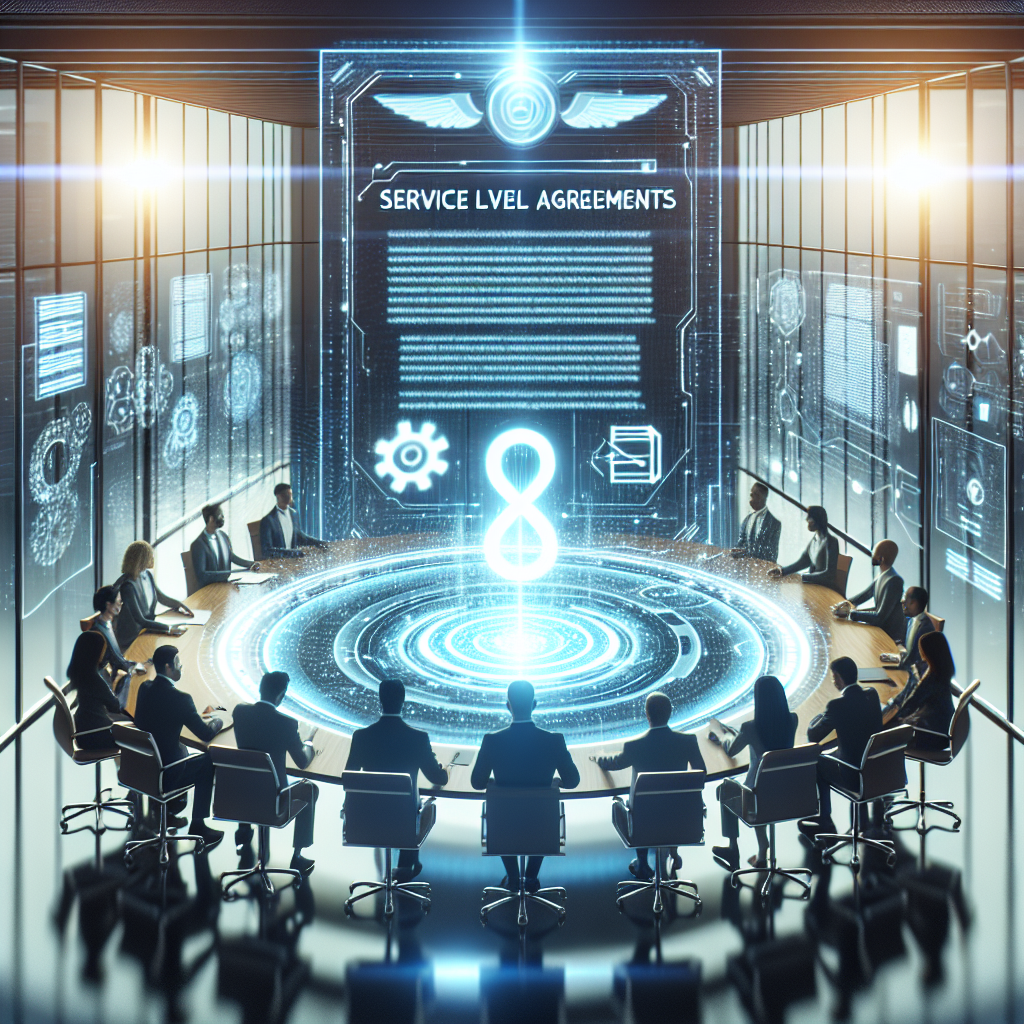Your cart is currently empty!
Tag: Future

The Future of Service Level Agreements: Trends and Innovations in SLA Management
Service Level Agreements (SLAs) have long been a staple in the world of business, providing a formal agreement between a service provider and a customer on the level of service that will be provided. However, as technology continues to evolve and customer expectations shift, the future of SLAs is also changing. In this article, we will explore some of the trends and innovations in SLA management that are shaping the future of service agreements.One of the key trends in SLA management is the shift towards more dynamic and flexible agreements. Traditional SLAs often involve fixed terms and metrics that may not always be relevant or reflective of the actual service being provided. In response to this, many organizations are moving towards more agile SLAs that can be adjusted in real-time based on changing customer needs and service capabilities. This allows for a more responsive and customer-centric approach to service delivery, ensuring that SLAs remain relevant and effective.
Another trend in SLA management is the increasing use of automation and artificial intelligence (AI) to streamline the monitoring and management of service agreements. AI-powered tools can analyze large amounts of data in real-time, flagging potential issues or deviations from SLA requirements before they become major problems. This proactive approach to SLA management can help to prevent service disruptions and improve overall service quality, leading to higher customer satisfaction and retention.
Additionally, there is a growing focus on outcome-based SLAs, where the emphasis is on the end result or value delivered to the customer, rather than simply meeting predefined service metrics. This shift towards outcome-based SLAs aligns more closely with the business goals of both the service provider and the customer, ensuring that SLAs are truly driving value and contributing to business success.
Innovations in SLA management are also being driven by the increasing complexity and interconnectedness of modern IT environments. As organizations adopt cloud services, IoT devices, and other emerging technologies, the traditional one-size-fits-all approach to SLAs is no longer sufficient. Instead, organizations are looking for more flexible and customizable SLA models that can accommodate the unique requirements of their specific technology stack and service ecosystem.
Overall, the future of service level agreements is evolving to meet the changing needs of businesses and customers in the digital age. By embracing dynamic, AI-driven, and outcome-based SLAs, organizations can ensure that their service agreements remain relevant, effective, and value-driven in an increasingly complex and competitive business environment.

The Future of IT Support: How MSPs are Changing the Game
The field of IT support is constantly evolving, and Managed Service Providers (MSPs) are at the forefront of this change. As technology becomes more complex and integrated into every aspect of our lives, businesses are turning to MSPs to provide them with the support and solutions they need to stay ahead of the curve.MSPs are changing the game by offering a wide range of services that go beyond traditional IT support. They are now providing proactive monitoring and management of IT systems, cloud services, cybersecurity, and more. This proactive approach helps businesses prevent issues before they occur, saving them time and money in the long run.
One of the key ways that MSPs are changing the game is by shifting the focus from reactive support to proactive management. Instead of waiting for something to go wrong and then fixing it, MSPs are now monitoring systems in real-time, identifying potential issues before they become major problems. This not only helps businesses avoid costly downtime but also improves overall efficiency and productivity.
Another way that MSPs are changing the game is by offering a more personalized approach to IT support. Instead of providing one-size-fits-all solutions, MSPs work closely with their clients to understand their unique needs and tailor their services accordingly. This level of customization ensures that businesses get the support they need, when they need it, without paying for unnecessary services.
Cybersecurity is also a major focus for MSPs, as the threat landscape continues to evolve and become more sophisticated. MSPs are now offering comprehensive security solutions, including threat detection, incident response, and compliance management. By partnering with an MSP, businesses can ensure that their data and systems are protected from cyber threats, giving them peace of mind and allowing them to focus on growing their business.
Overall, the future of IT support is bright, thanks to the innovative solutions and proactive approach of Managed Service Providers. By partnering with an MSP, businesses can stay ahead of the curve, improve efficiency, and protect their valuable data from cyber threats. The game is changing, and MSPs are leading the way towards a more secure and efficient future for IT support.

The Future of Service Level Agreements in a Digital Age
Service Level Agreements (SLAs) have long been a cornerstone of business relationships, outlining the level of service that can be expected from a provider. In the digital age, where technology is constantly evolving and businesses are increasingly reliant on digital services, the future of SLAs is being redefined.One of the key challenges facing SLAs in the digital age is the rapid pace of technological change. With new technologies emerging on a regular basis, it can be difficult for businesses to keep up with the latest developments and ensure that their SLAs are up to date. This has led to a shift towards more flexible and adaptable SLAs that can be easily updated to reflect changes in technology.
Another challenge is the increasing complexity of digital services. As businesses become more reliant on digital technologies, the services that they require are becoming more complex and interconnected. This can make it difficult to accurately define the scope of an SLA and ensure that all parties have a clear understanding of their responsibilities.
In response to these challenges, the future of SLAs is likely to see a greater emphasis on collaboration and communication between providers and customers. Rather than simply setting out a list of service levels and penalties for non-compliance, SLAs are likely to become more of a living document that is regularly reviewed and updated based on changing business needs and technological advancements.
One trend that is likely to shape the future of SLAs is the use of artificial intelligence and automation. AI-powered tools can help businesses track and monitor service levels in real time, allowing for more proactive management of SLAs and quicker resolution of any issues that arise. Automation can also help to streamline the process of updating and revising SLAs, making it easier for businesses to keep pace with technological changes.
Overall, the future of SLAs in the digital age is likely to be characterized by greater flexibility, collaboration, and automation. Businesses will need to adapt to the changing landscape of digital services and ensure that their SLAs are able to keep up with the pace of technological change. By embracing these trends, businesses can ensure that their SLAs continue to provide value and support their digital operations in an increasingly complex and interconnected world.

The Rise of IT Outsourcing: Trends and Predictions for the Future
In recent years, IT outsourcing has become increasingly popular among businesses looking to cut costs and improve efficiency. The rise of IT outsourcing can be attributed to a number of factors, including advancements in technology, globalization, and the growing demand for specialized skills.One of the key trends in IT outsourcing is the shift towards cloud computing. Cloud computing allows businesses to access IT resources and services over the internet, rather than having to invest in expensive hardware and software. This has made it easier for companies to outsource their IT needs to third-party providers, who can offer a range of services including infrastructure management, data storage, and application development.
Another trend in IT outsourcing is the increasing use of offshore providers. Many businesses are now turning to countries like India, the Philippines, and Eastern Europe for their IT outsourcing needs, as these regions offer a large pool of skilled IT professionals at a lower cost than in Western countries. This trend is expected to continue in the future, as businesses look to take advantage of the cost savings and expertise that offshore providers can offer.
Looking ahead, there are several predictions for the future of IT outsourcing. One trend that is expected to continue is the rise of automation and artificial intelligence in IT outsourcing services. As technology continues to advance, businesses will be able to automate more of their IT processes, reducing the need for human intervention and lowering costs even further.
Another prediction is the continued growth of the gig economy in IT outsourcing. As more businesses turn to freelance IT professionals for their outsourcing needs, we can expect to see a rise in platforms and marketplaces that connect businesses with independent contractors. This trend will allow businesses to access specialized skills on a temporary basis, without the need to hire full-time employees.
Overall, the future of IT outsourcing looks bright, with businesses continuing to benefit from the cost savings, efficiency, and expertise that outsourcing can offer. As technology continues to advance and the global marketplace becomes more interconnected, we can expect to see even more innovation and growth in the IT outsourcing industry in the years to come.

The Future of Managed Service Providers: Trends and Innovations
Managed Service Providers (MSPs) have become an essential part of the IT industry, providing businesses with a wide range of services to help them manage their technology needs. As technology continues to evolve at a rapid pace, the role of MSPs is also changing, with new trends and innovations shaping the future of the industry.One of the key trends that is driving the future of MSPs is the shift towards cloud-based services. With businesses increasingly moving their operations to the cloud, MSPs are playing a crucial role in helping them migrate and manage their cloud infrastructure. This trend is expected to continue to grow in the coming years, as more and more businesses realize the benefits of cloud computing and seek out MSPs to help them navigate this complex landscape.
Another important trend in the MSP industry is the increasing focus on cybersecurity. With the rise of cyber threats and data breaches, businesses are placing a greater emphasis on securing their networks and data. MSPs are stepping up to meet this demand by offering a range of cybersecurity services, such as threat detection, vulnerability assessments, and incident response. As cybersecurity threats continue to evolve, MSPs will need to stay ahead of the curve and invest in cutting-edge technologies to protect their clients’ data.
In addition to cloud services and cybersecurity, MSPs are also exploring new innovations such as artificial intelligence (AI) and automation. AI technology has the potential to revolutionize the way MSPs deliver services, by automating routine tasks and providing valuable insights into network performance and security. By harnessing the power of AI, MSPs can improve efficiency, reduce costs, and deliver a higher level of service to their clients.
As the MSP industry continues to evolve, it is clear that innovation will play a key role in shaping its future. MSPs that embrace new technologies and trends, such as cloud computing, cybersecurity, and AI, will be well-positioned to meet the changing needs of their clients and stay ahead of the competition. By staying ahead of the curve and investing in the latest innovations, MSPs can continue to provide valuable services to businesses and help them navigate the increasingly complex world of technology.

The Future of Service Level Agreements: Trends and Best Practices
In today’s fast-paced business environment, Service Level Agreements (SLAs) play a crucial role in ensuring that organizations are able to meet the expectations of their customers. An SLA is a contract between a service provider and a customer that outlines the level of service that will be provided, as well as the consequences if those service levels are not met. As technology continues to evolve and consumer expectations continue to rise, it is important for organizations to stay ahead of the curve when it comes to their SLAs.One of the key trends in the future of SLAs is the increasing focus on customer experience. In today’s digital age, customers have more choices than ever before, and they are quick to switch to a competitor if they are not satisfied with the level of service they receive. As a result, organizations are placing a greater emphasis on creating SLAs that prioritize the customer experience, rather than just focusing on meeting technical metrics. This means that SLAs are becoming more customer-centric, with a focus on factors such as response times, resolution times, and overall customer satisfaction.
Another trend in the future of SLAs is the use of technology to monitor and enforce SLAs in real-time. With the rise of artificial intelligence and machine learning, organizations are able to track and analyze data in real-time to ensure that SLAs are being met. This allows organizations to quickly identify any issues or deviations from the agreed-upon service levels, and take corrective action before they impact the customer experience. Additionally, technology can also be used to automate the enforcement of SLAs, reducing the risk of human error and ensuring that service levels are consistently met.
In terms of best practices for creating effective SLAs, it is important for organizations to involve stakeholders from across the organization in the creation process. This includes not only the IT department, but also key business units such as customer service, sales, and marketing. By involving a diverse group of stakeholders in the creation of SLAs, organizations can ensure that the SLAs are aligned with the overall business objectives and are able to meet the needs of all stakeholders.
Additionally, it is important for organizations to regularly review and update their SLAs to ensure that they remain relevant and effective. As business requirements and technology continue to evolve, organizations must be willing to adapt their SLAs to meet these changing needs. This may involve revisiting existing SLAs, adding new metrics or service levels, or removing outdated requirements. By regularly reviewing and updating their SLAs, organizations can ensure that they remain competitive and are able to meet the ever-changing needs of their customers.
In conclusion, the future of Service Level Agreements is evolving to meet the changing needs of organizations and customers. By focusing on customer experience, leveraging technology, and involving stakeholders in the creation process, organizations can create effective SLAs that help them meet and exceed customer expectations. By following best practices and regularly reviewing and updating their SLAs, organizations can ensure that they remain competitive and are able to deliver high-quality service to their customers.

The Future of Maintenance: Embracing Proactive Strategies
Maintenance is a crucial aspect of any industry, ensuring that equipment and facilities are functioning at optimal levels to prevent breakdowns and costly repairs. Traditionally, maintenance has been a reactive process, with technicians responding to issues as they arise. However, as technology continues to advance, the future of maintenance lies in embracing proactive strategies to prevent problems before they occur.One key aspect of proactive maintenance is predictive maintenance, which uses data and analytics to forecast when equipment is likely to fail. By monitoring key performance indicators and analyzing trends, maintenance teams can schedule repairs and replacements before a breakdown occurs, saving time and money in the long run.
Another proactive maintenance strategy is preventive maintenance, which involves regularly scheduled inspections and maintenance tasks to keep equipment in optimal condition. By following a preventive maintenance schedule, companies can reduce the risk of unexpected failures and prolong the lifespan of their assets.
Implementing a proactive maintenance strategy requires a shift in mindset from reactive to proactive thinking. This includes investing in the right technology and tools, such as sensors and monitoring systems, to gather data and monitor equipment in real-time. It also involves training technicians to analyze data and make informed decisions about when to perform maintenance tasks.
Embracing proactive maintenance strategies can have numerous benefits for companies. Not only can it reduce downtime and maintenance costs, but it can also improve overall equipment reliability and performance. By taking a proactive approach to maintenance, companies can stay ahead of potential issues and ensure that their operations run smoothly and efficiently.
In conclusion, the future of maintenance lies in embracing proactive strategies that leverage technology and data to prevent issues before they occur. By shifting towards a proactive mindset and investing in the right tools and training, companies can improve their maintenance practices and ultimately, their bottom line. Proactive maintenance is not just a trend, but a necessary step towards ensuring the longevity and success of any industry.

The Future of Business: How Cloud Computing is Revolutionizing Operations
In today’s fast-paced business world, staying ahead of the competition is crucial. One of the key ways in which businesses are revolutionizing their operations is through the use of cloud computing. Cloud computing, which involves storing and accessing data and programs over the internet instead of on a physical computer or server, is changing the way businesses operate and helping them become more efficient, flexible, and cost-effective.One of the main benefits of cloud computing is its scalability. With traditional on-premises systems, businesses have to invest in expensive hardware and software to accommodate growth. However, with cloud computing, businesses can easily scale up or down depending on their needs, without the need for significant upfront investment. This flexibility allows businesses to quickly adapt to changing market conditions and seize new opportunities without being held back by outdated technology.
Another key advantage of cloud computing is its cost-effectiveness. By using cloud services, businesses can reduce their IT infrastructure costs, as they no longer need to invest in expensive hardware, software, or maintenance. Instead, businesses can pay for only the resources they use, making it a more cost-efficient option for many organizations. Additionally, cloud computing allows businesses to access the latest technology and software without having to make large capital investments, enabling them to stay competitive in today’s rapidly evolving market.
Cloud computing also offers improved collaboration and communication within businesses. With cloud-based tools such as file sharing and collaboration platforms, employees can work together more efficiently, regardless of their location. This increased connectivity and collaboration can lead to improved productivity and innovation within the organization, as employees can easily share ideas, information, and resources in real-time.
Furthermore, cloud computing offers enhanced security and data protection. Cloud service providers invest heavily in security measures to protect their clients’ data, often employing advanced encryption techniques and regular security audits to ensure data is kept safe from cyber threats. This level of security can give businesses peace of mind, knowing that their sensitive information is protected from potential breaches and data loss.
In conclusion, cloud computing is revolutionizing the way businesses operate by offering scalability, cost-effectiveness, improved collaboration, and enhanced security. As the business landscape continues to evolve, cloud computing will play an increasingly important role in helping businesses stay competitive, agile, and efficient in the digital age. Businesses that embrace cloud computing now will be well-positioned to thrive in the future and drive innovation in their respective industries.

Building a Resilient IT Infrastructure Management Framework for the Future
In today’s rapidly evolving digital landscape, having a resilient IT infrastructure management framework is crucial for the success of any organization. With the increasing complexity of technology and the growing threat of cyber attacks, businesses need to be prepared for any potential disruptions to their IT systems. Building a resilient IT infrastructure management framework is essential for ensuring the continuity of operations and protecting sensitive data.One of the key components of a resilient IT infrastructure management framework is having a comprehensive disaster recovery plan in place. This plan should outline the steps that need to be taken in the event of a cyber attack, natural disaster, or any other unforeseen event that could disrupt IT operations. By having a solid disaster recovery plan in place, businesses can minimize downtime and quickly restore their systems to full functionality.
Another important aspect of building a resilient IT infrastructure management framework is implementing robust security measures. With the increasing number of cyber threats targeting businesses of all sizes, it is essential to have strong security protocols in place to protect sensitive data and prevent unauthorized access to IT systems. This includes regularly updating security software, implementing multi-factor authentication, and conducting regular security audits to identify and address any vulnerabilities.
In addition to disaster recovery and security measures, businesses should also focus on implementing scalable and flexible IT infrastructure solutions. As technology continues to evolve, organizations need to be able to adapt quickly to changing market conditions and customer demands. By investing in scalable IT infrastructure solutions, businesses can easily expand their operations and support growth without having to completely overhaul their IT systems.
Furthermore, businesses should also prioritize investing in cloud-based IT infrastructure solutions. Cloud computing offers businesses the flexibility and scalability they need to adapt to changing market conditions, as well as the ability to access their data and applications from anywhere in the world. By leveraging cloud-based IT infrastructure solutions, businesses can reduce costs, improve efficiency, and enhance their overall agility.
In conclusion, building a resilient IT infrastructure management framework is essential for the long-term success of any organization. By implementing a comprehensive disaster recovery plan, robust security measures, scalable IT infrastructure solutions, and cloud-based technologies, businesses can ensure the continuity of operations and protect sensitive data in the face of any potential disruptions. By investing in a resilient IT infrastructure management framework, businesses can future-proof their operations and position themselves for success in the rapidly evolving digital landscape.

The Future of Remote Monitoring: Trends to Watch in 2021 and Beyond
Remote monitoring has become an essential tool for businesses in various industries, allowing them to keep track of their assets, equipment, and systems from a distance. With advancements in technology and the increasing need for remote solutions, the future of remote monitoring looks promising. Here are some trends to watch in 2021 and beyond.1. Internet of Things (IoT) Integration: With the proliferation of IoT devices, remote monitoring systems are becoming more interconnected and intelligent. IoT sensors can collect data from various sources, providing real-time insights and alerts to remote monitoring platforms. This integration allows businesses to monitor and manage their assets more effectively, leading to improved efficiency and reduced downtime.
2. Artificial Intelligence (AI) and Machine Learning: AI and machine learning algorithms are being used to analyze vast amounts of data collected by remote monitoring systems. These technologies can identify patterns, anomalies, and trends, enabling businesses to predict potential issues before they occur. AI-powered remote monitoring solutions can also automate tasks, making operations more efficient and cost-effective.
3. Cloud-Based Solutions: Cloud-based remote monitoring platforms are becoming increasingly popular due to their scalability, flexibility, and accessibility. These solutions allow businesses to access real-time data from anywhere, using any device with an internet connection. Cloud-based remote monitoring also provides better security, as data is stored in secure servers and can be easily backed up and restored.
4. 5G Technology: The rollout of 5G technology is expected to revolutionize remote monitoring by providing faster and more reliable connectivity. With 5G networks, businesses can transmit and receive data in real-time, enabling more responsive remote monitoring solutions. This technology will also support the increasing number of IoT devices and sensors used for remote monitoring, enhancing overall system performance.
5. Predictive Maintenance: Remote monitoring systems are evolving from reactive to proactive maintenance approaches. By analyzing data collected from sensors and equipment, businesses can predict when maintenance is needed before a breakdown occurs. This predictive maintenance strategy helps businesses avoid costly downtime and repairs, improving overall operational efficiency.
6. Cybersecurity Measures: As remote monitoring systems become more interconnected and data-driven, cybersecurity is a growing concern. Businesses need to implement robust cybersecurity measures to protect their sensitive data and prevent cyber threats. This includes encrypting data, implementing multi-factor authentication, and regularly updating security protocols to stay ahead of potential threats.
In conclusion, the future of remote monitoring looks bright, with advancements in technology driving innovation and efficiency in various industries. By keeping an eye on these trends and leveraging the latest technologies, businesses can enhance their remote monitoring capabilities and stay ahead of the competition in 2021 and beyond.
